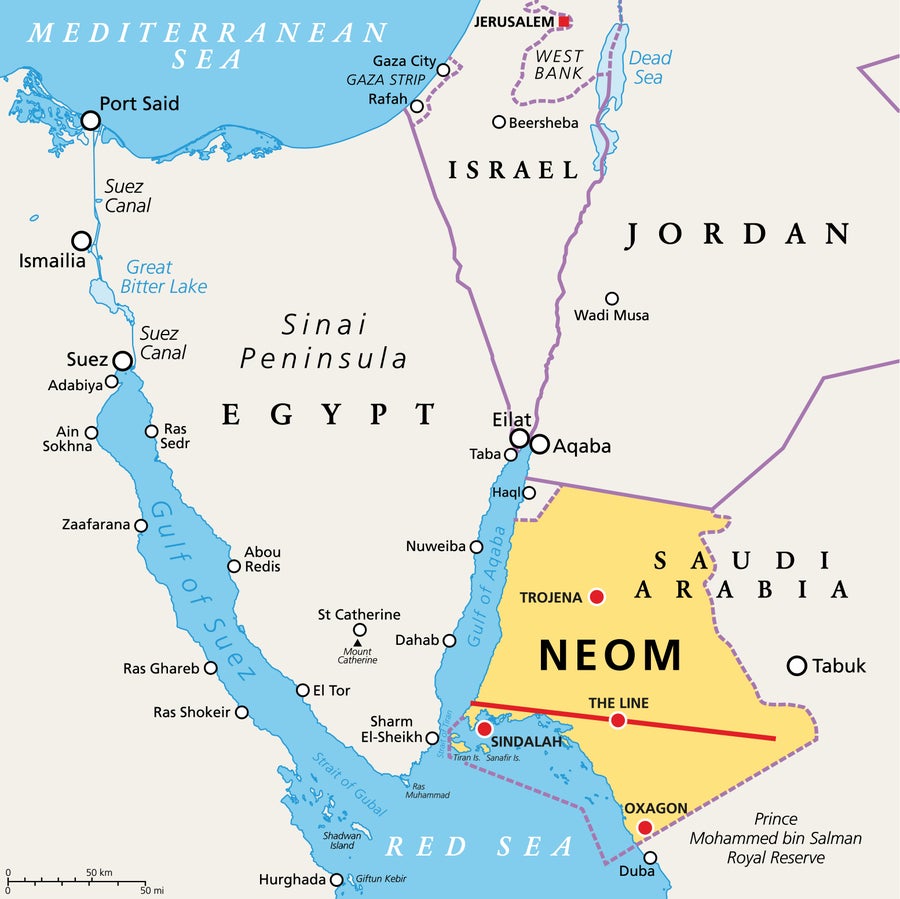In October 2022 construction work began on a megaproject called “the Line,” a 106-mile-long city in the Saudi Arabian desert. The plan is for nine million people to live within a mere 13 square miles—an area comparable to Burlington, Vt., which is home to only about 45,000 inhabitants.
This feat will be achieved through a unique urban planning concept: the Line will consist of two long rows of about 1,600-foot skyscrapers that will face each other at roughly 650 feet, enclosing the desert city like a wall. In addition, urban life will be as sustainable as possible. Cars will have no place in this futuristic city. The entire energy supply will be emission-free.
But in a paper published in June in npj Urban Sustainability, mathematician Rafael Prieto-Curiel and physicist Dániel Kondor, both at the Complexity Science Hub Vienna (CSH), argue that the Line is not particularly sustainable from a mathematical perspective. “A line is the least efficient possible shape of a city," Prieto-Curiel said in a press release about the research from CSH. He added that, instead, cities are typically round.
On supporting science journalism
If you're enjoying this article, consider supporting our award-winning journalism by subscribing. By purchasing a subscription you are helping to ensure the future of impactful stories about the discoveries and ideas shaping our world today.
The main problem with the linear approach is the huge distances involved. Pick two people at random from the planned city, and they will be, on average, 35 miles apart, Prieto-Curiel and Kondor calculate. By way of comparison, consider the South African metropolis of Johannesburg. Its greater metropolitan area has a similar number of inhabitants as the Line will in the future but spreads over 853 square miles. In Johannesburg, two people are only about 21 miles apart on average.

In Saudi Arabia, construction on "the Line" began in October 2022. Credit: PeterHermesFurian/Getty Images
High-speed rail is intended to solve transport and mobility issues in the Line. But for this solution to work, the city will need around 86 stations so that every inhabitant has a stop within walking distance in this car-free metropolis. The many stops will increase the duration of each journey—and prevent trains from reaching the desired high speeds. In addition, a commuter will spend more than 60 minutes traveling to their destination on average, Prieto-Curiel and Kondor calculate.
The Advantage of Two-Dimensional Cities
According to the researchers, a more efficient solution is obvious: “the Circle.” If the skyscrapers planned in the Line were arranged in the round, that would solve the problems of long distances. A circle with the same area as the Line (13 square miles) has a diameter of merely 4.1 miles.
The average distance between two people picked at random would then be just 1.8 miles. A high-speed train would not be necessary at all because theoretically everything would be within walking distance. A few additional bus lines and bicycle routes would suffice. The round city shape would be less sensational from a design perspective but more “desirable since it reduces commuting distances and the energy required for transport,” Prieto-Curiel and Kondor write in their paper.
The main reason for this advantage is that, from a mathematical perspective, a circular area is two-dimensional, while a line is one-dimensional. In one dimension, the number of reachable places scales linearly with the distance a person is willing to walk. In two dimensions, the number increases with the square of the distance.
Furthermore, one-dimensional structures are much more vulnerable than those in higher dimensions. For instance, if a fire breaks out in a train station in the Line, many people will be directly cut off from much of the city.
Amid his and Kondor’s critiques, Prieto-Curiel offered one positive note in the recent press release: attention to urban form and development is timely and important, he said. “Cities, especially in Africa, are growing,” Prieto-Curiel added.
This article originally appeared in Spektrum der Wissenschaft and was reproduced with permission.
